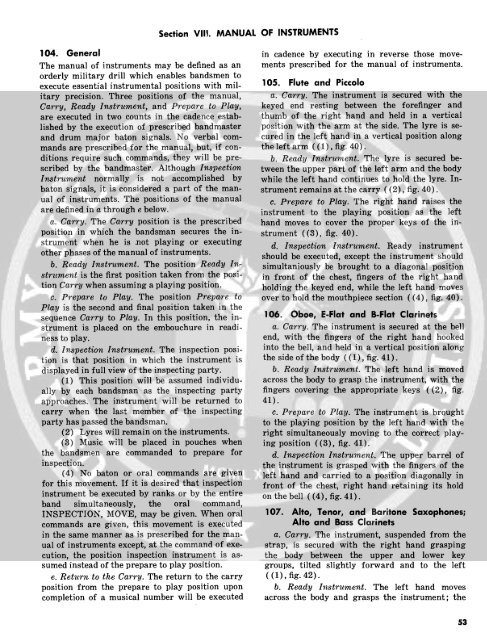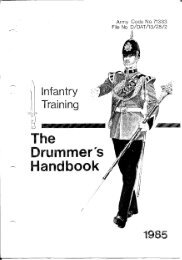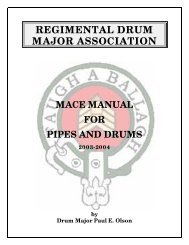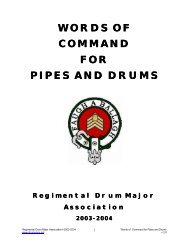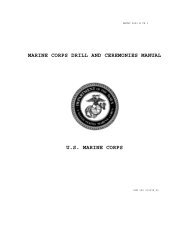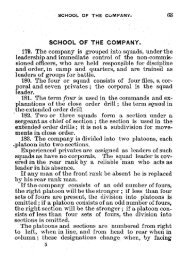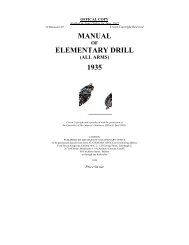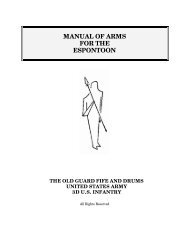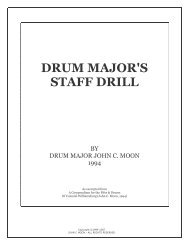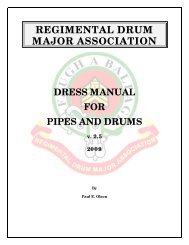The Military Band - Regimental Drum Major Association
The Military Band - Regimental Drum Major Association
The Military Band - Regimental Drum Major Association
Create successful ePaper yourself
Turn your PDF publications into a flip-book with our unique Google optimized e-Paper software.
Section VIII. MANUAL OF INSTRUMENTS<br />
104. General in cadence by executing in reverse those move-<br />
<strong>The</strong> manual of instruments may be defined as an ments prescribed for the manual of instruments.<br />
orderly military drill which enables bandsmen to<br />
execute essential instrumental positions with mil- 105. Flute and Piccolo<br />
itary precision. Three positions of the manual, a. Carry. <strong>The</strong> instrument is secured with the<br />
Carry, Ready Instrument, and Prepare to Play, keyed end resting between the forefinger and<br />
are executed in two counts in the cadence estab- thumb of the right hand and held in a vertical<br />
lished by the execution of prescribed bandmaster position with the arm at the side. <strong>The</strong> lyre is seand<br />
drum major baton signals. No verbal com- cured in the left hand in a vertical position along<br />
mands are prescribed for the manual, but, if con- the left arm ((1), fig. 40).<br />
ditions require such commands, they will be pre- b. Ready Instrument. <strong>The</strong> lyre is secured bescribed<br />
by the bandmaster. Although Inspection tween the upper part of the left arm and the body<br />
Instrument normally is not accomplished by while the left hand continues to hold the lyre. Inbaton<br />
signals, it is considered a part of the man- strument remains at the carry ((2), fig. 40).<br />
ual of instruments. <strong>The</strong> positions of the manual c. Prepare to Play. <strong>The</strong> right hand raises the<br />
are defined in a through e below, instrument to the playing position as the left<br />
a. Carry. <strong>The</strong> Carry position is the prescribed hand moves to cover the proper keys of the inposition<br />
in which the bandsman secures the in- strument ((3), fig. 40).<br />
strument when he is not playing or executing d. Inspection Instrument. Ready instrument<br />
other phases of the manual of instruments. should be executed, except the instrument should<br />
b. Ready Instrument. <strong>The</strong> position Ready In- simultaniously be brought to a diagonal position<br />
strument is the first position taken from the posi- in front of the chest, fingers of the right hand<br />
tion Carry when assuming a playing position. holding the keyed end, while the left hand moves<br />
c. Prepare to Play. <strong>The</strong> position Prepare to over to hold the mouthpiece section ((4), fig. 40).<br />
Play is the second and final position taken in the<br />
sequence Carry to Play. In this position, the in- 106. Oboe, E-Flat and B-Flat Clarinets<br />
strument is placed on the embouchure in readi- a. Carry. <strong>The</strong> instrument is secured at the bell<br />
ness to play. end, with the fingers of the right hand hooked<br />
d. Inspection Instrument. <strong>The</strong> inspection posi- into the bell, and held in a vertical position along<br />
tion is that position in which the instrument is the side of the body ((1), fig. 41).<br />
displayed in full view of the inspecting party. b. Ready Instrument. <strong>The</strong> left hand is moved<br />
(1) This position will be assumed individu- across the body to grasp the instrument, with the<br />
ally by each bandsman as the inspecting party fingers covering the appropriate keys ((2), fig.<br />
approaches. <strong>The</strong> instrument will be returned to 41).<br />
carry when the last member of the inspecting c. Prepare to Play. <strong>The</strong> instrument is brought<br />
party has passed the bandsman. to the playing position by the left hand with the<br />
(2) Lyres will remain on the instruments. right simultaneously moving to the correct play-<br />
(3) Music will be placed in pouches when ing position ((3), fig. 41).<br />
the bandsmen are commanded to prepare for d. Inspection Instrument. <strong>The</strong> upper barrel of<br />
inspection. the instrument is grasped with the fingers of the<br />
(4) No baton or oral commands are given left hand and carried to a position diagonally in<br />
for this movement. If it is desired that inspection front of the chest, right hand retaining its hold<br />
instrument be executed by ranks or by the entire on the bell ((4), fig. 41).<br />
band simultaneously, the oral command,<br />
INSPECTION, MOVE, may be given. When oral 107. Alto, Tenor, and Baritone Saxophones;<br />
commands are given, this movement is executed Alto and Bass Clarinets<br />
in the same manner as is prescribed for the man- a. Carry. <strong>The</strong> instrument, suspended from the<br />
ual of instruments except, at the command of exe- strap, is secured with the right hand grasping<br />
cution, the position inspection instrument is as- the body between the upper and lower key<br />
sumed instead of the prepare to play position. groups, tilted slightly forward and to the left<br />
e. Return to the Carry. <strong>The</strong> return to the carry ((1), fig. 42).<br />
position from the prepare to play position upon b. Ready Instrument. <strong>The</strong> left hand moves<br />
completion of a musical number will be executed across the body and grasps the instrument; the<br />
53


